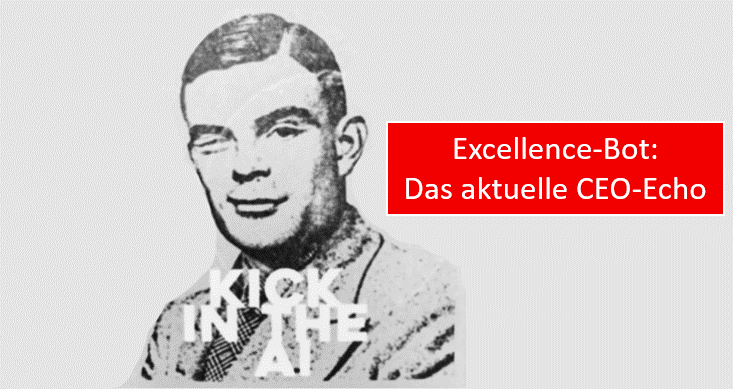Das digitale Medienecho auf alle DAX- und MDAX-Manager – hier das öffentliche Ranking.
About the CEO Echo
.companion ist spezialisiert auf digitale Evaluation und Organisation von Kommunikation und Marketing. Wir untersuchen und interpretieren laufend das digitale Medienecho zu allen DAX- und MDAX-CEOs. Gemessen wird mit dem marktführenden Media-Monitoring-Tool Talkwalker. Durchsucht werden alle öffentlich zugänglichen digitalen Medieninhalte global, englisch und deutsch, Social und Web, privat und redaktionell (vor der Bezahlschranke). Analyse und Interpretation der Daten übernimmt ein hauseigener Kennzahl-Bot, der die Daten monatlich verarbeitet und diesen Text vollautomatisch erzeugt. Der Kennzahl-Bot erzeugt auf Wunsch auch individuelle Auswertungen.
Bestellen Sie hier Ihre individuelle Auswertung!
CEO-Echo im Oktober 2019: 15% weniger Erwähnungen von DAX- und MDAX-Managern
Im vergangenen Monat fand der .companion-Kennzahl-Bot im globalen Medienecho 15% weniger CEO-Erwähnungen als im Schnitt der letzten Monate. Das CEO-Echo wurde insgesamt zu 61% durch redaktionelle Online-Angebote erzeugt, der Social-Media-Anteil lag bei 39%. Insgesamt aktivierten die Inhalte des CEO-Echos ihre Leser im Oktober um 78% häufiger als bisher.
Die Nennungen aller DAX/MDAX-Chefs fanden zu 78% im Kontext von Finanznachrichten statt. Dagegen hatten 22% einen redaktionellen inhaltlichen Kontext, der sich besser eignet, um Themen zu setzen und Reputation zu beeinflussen. Insgesamt hatte das digitale Medienecho auf die Top-Angestellten eine eher durchschnittliche Färbung, mit ähnlich viel positiver wie negativer Tonalität.
Fußabdruck: Jennifer Morgan (SAP) dominiert 12% des gesamten CEO-Echos
Welchen Anteil hat eine DAX/MDAX-Chefin am gesamten CEO-Echo, ob freiwillig oder unfreiwillig? Diese Frage beantwortet der CEO-Fußabdruck.
Im Oktober erhielt Jennifer Morgan (SAP) die größte mediale Aufmerksamkeit. Sie hatte einen Share of Voice von 12% und damit den größten Fußabdruck aller Vorstände. Auf Platz zwei und drei folgen in diesem Monat Dr. Mathias Döpfner (Springer) mit 11% sowie Herbert Diess (Volkswagen) mit 11% Anteil an allen Nennungen.
Morgans Echo fand zu 17% nicht im Finanz-Kontext statt und eignete sich damit durchschnittlich zum Setzen von Themen und Inhalten. Das Echo der SAP-Chefin stammte zu 57% aus redaktionellen Medien, zu 43% aus Social Media. Inhalte, die Morgan nannten, erzeugten 11 Interaktionen pro Erwähnung. Das entspricht einer starken Leseraktivierung (Platz 7 aller CEOs). In Summe zeigten die redaktionellen inhaltlichen Nennungen von Jennifer Morgan eine sehr schwache Färbung mit einer Tonalität, die ähnlich viel positiver wie negativer Tonalität war.
Communication Excellence: Fraport setzt mit Stefan Schulte am besten Inhalte in Redaktionen
Gute Medienarbeit will Themen setzen und Reputation aufbauen. Am besten erreicht wird dies durch Platzierung in Beiträgen, die keine Finanzmeldung sind und von redaktionellen Medien publiziert werden. Welchen DAX/MDAX-Unternehmen das gelingt, zeigt unser Kennzahl-Bot mit der Rangliste zur Communication Excellence.
Auf Platz 1 findet sich im Oktober Stefan Schulte (Fraport). Sein digitales Echo hatte vor der Paywall zu 74% einen inhaltlichen Kontext jenseits von Geschäftszahlen. Seine Inhalte zeigten 20 Interaktionen pro Erwähnung, was einer sehr starken Leseraktivierung entspricht. Darüber hinaus hatten die Texte eine starke Tonalität mit mehr negativen als positiven Färbungen. Im Ergebnis erzielt das Echo auf den Chef von Springer 3.1 Punkte. Auf Platz zwei und drei der Communication Excellence folgen Ralf W. Dieter (Dürr) mit 2.8 Punkten und Rolf Martin Schmitz (RWE) mit 1.9 Punkten.
Social Excellence: Tim Höttges (Telekom) mit dem besten Social-Media-Echo
„Social“ ist kein Selbstzweck. Wer aber etwas bewirken will bei Meinungsbildnern außerhalb von Redaktionen (Influencern) oder bei Konsumenten und digitalen Eliten, die massenmedial nicht gut erreichbar sind, der muss möglichst häufig und durchschlagend in Social Media erwähnt werden. Ob das gelingt, beantwortet der Social Excellence Index. Unser Kennzahl-Bot interpretiert den Anteil der Erwähnungen in Social Media, die Stärke der Leseraktivierung sowie ihre emotionale Färbung.
Im vergangenen Monat führt Tim Höttges (Telekom) mit 1.9 Punkten auf Platz 1 der Rangliste. Er lag damit vor Dr. Mathias Döpfner (Springer) mit 1.7 Punkten und Harald Krüger (BMW) mit 1.3 Punkten. Das Echo des Telekom-CEOS war zu 73% „social“. Hier war die Leseraktivierung mit 4 Reaktionen auf eine Erwähnung eher durchschnittlich; die Tonalität seiner Erwähnungen war zu 23% positiv.
Responsibility Excellence: Rolf Buch (Vonovia) mit bester Resonanz zu gesellschaftlicher Verantwortung
Der .companion-Kennzahl-Bot ermittelt auch, ob DAX/MDAX-Chefs im digitalen Medienecho als Führungskraft im Umfeld der nachhaltigen Entwicklungsziele der UNO erscheinen, also z.B. im Kontext von sozialer Verantwortung oder Klima- und Umweltschutz. Wie gut das gelungen ist, zeigt unser Responsibility-Index. Für ihn interpretiert der Kennzahl-Bot nur die Erwähnungen, die in diesem Themenkontext stattfanden.
Von Platz 1 der Responsibility-Rangliste grüßt im Oktober Rolf Buch (Vonovia). Das Echo des Vonovia-Chefs bezog sich zu 59% auf Themen der gesellschaftlichen Verantwortung. Hier lag seine Leseraktivierung bei 3, was einem schwachen Interaktionsniveau entspricht. Die Tonalität sehr stark ausgeprägt, mit deutlich mehr positiven als negativen Sentiments. Insgesamt erzielte Buchs Responsibility-Index so 2.7 Punkte. Auf Platz 2 folgt Rolf Martin Schmitz (RWE) mit 2.4 Punkten, auf Platz 3 Herbert Diess (Volkswagen) mit 1.2 Punkten.
Investor Excellence: Rice Powell (Fresenius Medical Care) mit bestem Finanz-Echo
CEO-Erwähnungen im Umfeld von Bilanzzahlen bieten wenig Raum, um inhaltliche Akzente zu setzen, sind aber entscheidend für Vertrauensbildung bei Investoren.
Als Top-Kommunikator für Investoren ermittelte der .companion-Kennzahl-Bot im Oktober Fresenius Medical Care für Rice Powell. In diesem Umfeld ermittelt der Kennzahl-Bot, welche CEOs wie gut erwähnt wurden, und bildet einen Index zur Investorenkommunikation. 96% seiner Mentions bezogen sich auf das Finanzumfeld, das sind 1.6-mal so viele wie im Durchschnitt. Seine Leseraktivierung war sehr stark und lag bei 4,2. Die Tonalität war stark ausgeprägt, mit deutlich mehr positiven als negativen Sentiments.
